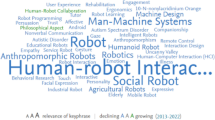Abstract
Robot personalities are today painstakingly hand-crafted by content creators who specify motions, facial animations, and scripts in order to convey a unifying sense of character via interactions. While user preferences can be incorporated by modifying these behaviors to some degree, such as by inserting a user’s name or preference into a script, by and large new content must be continually created in order to maintain the robot’s ‘freshness.’ This content treadmill represents a long tail of work that diverts resources away from improving the underlying capabilities of the robot. Here we outline a novel method for defining robot personality that allows each robot to have and express a unique personality through varying behaviors that reduces the need for content creation.





Similar content being viewed by others
Notes
Merriam-Webster lists “the complex of characteristics that distinguishes an individual” as one definition of personality.
References
Cha E, Dragan AD, Srinivasa SS (2015) Perceived robot capability. In: Robot and human interactive communication, pp 541–548
Dragan AD, Lee KCT, Srinivasa SS (2013) Legibility and predictability of robot motion. In: International conference on human-robot interaction, pp 301–308
Gielniak MJ, Thomaz AL (2012) Enhancing interaction through exaggerated motion synthesis. In: International conference on human-robot interaction, pp 375–382
Grollman DH (2016) Infinite personality space for non-fungible robots. In: International conference on social robotics, pp 94–103
Jung MF, Lee JJ, DePalma N, Adalgeirsson SO, Hinds PJ, Breazeal C (2013) Engaging robots: easing complex human-robot teamwork using backchanneling. In: Computer supported cooperative work, pp 1555–1566
Kidd C (2008) Designing for long-term human-robot interaction and application to weight loss. PhD thesis, MIT
Kiesler S, Goetz J (2002) Mental models of robotic assistants. In: CHI ’02 extended abstracts on human factors in computing systems, pp 576–577
Kirby R (2010) Social robot navigation. PhD thesis, Robotics Institute, Carnegie Mellon University, Pittsburgh, PA
Moshkina LV (2011) An integrative framework of time-varying affective robotic behavior. PhD thesis, Atlanta, GA, USA
Mumm J, Mutlu B (2011) Human-robot proxemics: physical and psychological distancing in human-robot interaction. In: International conference on human-robot interaction, pp 331–338
Phillips EK, Schaefer K, Billings DR, Jentsch F, Hancock PA (2016) Human-animal teams as an analog for future human-robot teams: influencing design and fosterning trust. J Hum Robot Interact 5(1):100–125
Sheh RKM, Hengst B, Sammut C (2011) Behavioural cloning for driving robots over rough terrain. In: International conference on robotic systems, pp 732–737
Sundar SS, Waddell TF, Jung EH (2016) The hollywood robot syndrome: media effects on older adults’ attitudes toward robots and adoption intentions. In: International conference on human robot interaction, pp 343–350
Sutcliffe A, Grollman D, Pineau J (2014) Estimating people’s subjective experiences of robot behavior. In: AAAI fall symposium on AI for HRI
Wada K, Shibata T (2006) Robot therapy in a care house—its sociopsychological and physiological effects on the residents. In: International conference on robotics and automation
Acknowledgements
Many thanks to Michael Gielniak for writing the simulator and running studies, and to Dave Hygh, Quentin Michelet, and Patrick Martin for making the robots and keeping them running.
Author information
Authors and Affiliations
Corresponding author
Rights and permissions
About this article
Cite this article
Grollman, D.H. Avoiding the Content Treadmill for Robot Personalities. Int J of Soc Robotics 10, 225–234 (2018). https://doi.org/10.1007/s12369-017-0451-6
Accepted:
Published:
Issue Date:
DOI: https://doi.org/10.1007/s12369-017-0451-6




